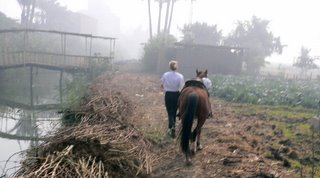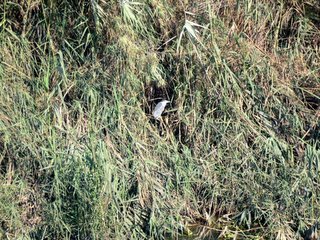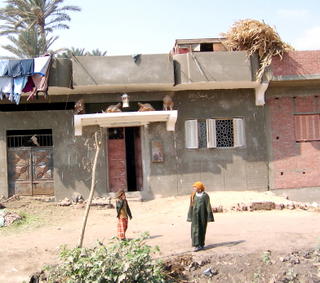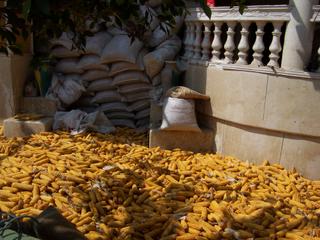
This ride started on Friday with one group of friends and ended on Saturday with another friend and different horses. Odd? A little, but I've been wanting to find a way from my farm to the antiquities of Memphis for some time. It's slightly southeast of me, but figuring out a way to get there safely through the countryside is the trick. I have to cross a main road that runs on both sides of a major canal and my goal is always to stay off the asphalt as much as possible. Research on Google Earth had shown me that there is an area in the farmland that is sand just to the north of the area where I was sure that Memphis would be found. Since Memphis is in the more urban area of Badrasheen, I figured that this sandy space might prove to be a good entrance to Memphis. On Friday, my housemate, a confirmed distance runner, and a friend and I went out on the first attempt to find a way to the sandy space. Tracy wanted to get in a 20 km run, while Cristina and I were happy to keep ourselves in the saddle for the distance. We did bring along a horse for Tracy, the dependable Bunduq, who became quite adept at jogging along next to or behind her on the narrow trails.
 On Friday we didn't make it to the sandy area. Unfortunately, I made a navigational error that landed us in the middle of a village where a crowd of bored children were on the lookout for something exciting to do. The something exciting turned out to be running along in pursuit of three women with horses shouting for money, chanting and generally being amazingly annoying. Usually, if I run across one or two annoying children I stop at the next adult and ask for a bit of help, pointing out that I'm simply riding my horse and I don't carry money, pens, or lighters, and the adults are more than happy to pull the over-eager kids up short. This time, however, we were engulfed in a mob of about 20 children and the adults were pretty much powerless. As Tracy wanted to get her running in, Cristina and I covered the area between her and the kids so that they couldn't hassle her and Bunduq. The time spent training the horses to be hassle-proof really paid off as the odd stone or stick seemed not to bother them at all, and they trucked on down the road ignoring the chanting and shouting. After about 20 minutes we came to a bridge taking us back over the main canal to my usual riding area where some farmers ran the crowd off, leaving us in peace.
On Friday we didn't make it to the sandy area. Unfortunately, I made a navigational error that landed us in the middle of a village where a crowd of bored children were on the lookout for something exciting to do. The something exciting turned out to be running along in pursuit of three women with horses shouting for money, chanting and generally being amazingly annoying. Usually, if I run across one or two annoying children I stop at the next adult and ask for a bit of help, pointing out that I'm simply riding my horse and I don't carry money, pens, or lighters, and the adults are more than happy to pull the over-eager kids up short. This time, however, we were engulfed in a mob of about 20 children and the adults were pretty much powerless. As Tracy wanted to get her running in, Cristina and I covered the area between her and the kids so that they couldn't hassle her and Bunduq. The time spent training the horses to be hassle-proof really paid off as the odd stone or stick seemed not to bother them at all, and they trucked on down the road ignoring the chanting and shouting. After about 20 minutes we came to a bridge taking us back over the main canal to my usual riding area where some farmers ran the crowd off, leaving us in peace. Most of my interactions with the village children are much less stressful. For example, a friend asked me for some photos to illustrate an article on the countryside for a French magazine and I got a number of lovely shots of a group of children with their mothers outside of a house with a new Haj painting depicting the plane and the Kaaba in Mecca. I'm printing some of the photos for the women and children since they have never seen themselves in photographs before. On the whole, I really like the village people. This particular crowd was not at all representative of the farming area people. From now on we avoid this village, which isn't so difficult. At any rate, we were glad to be on familiar ground and we travelled back to the farm through the fields.
Most of my interactions with the village children are much less stressful. For example, a friend asked me for some photos to illustrate an article on the countryside for a French magazine and I got a number of lovely shots of a group of children with their mothers outside of a house with a new Haj painting depicting the plane and the Kaaba in Mecca. I'm printing some of the photos for the women and children since they have never seen themselves in photographs before. On the whole, I really like the village people. This particular crowd was not at all representative of the farming area people. From now on we avoid this village, which isn't so difficult. At any rate, we were glad to be on familiar ground and we travelled back to the farm through the fields.  On Saturday I tried again with my friend Nathalie and two other horses, Stella and Dooby. The estimate I had of the distance was about 20 km round trip. We had done approximately 18 km on Friday, so those horses deserved a day off. This time we stayed to the west of the main Mariouteya Canal all the way south to the asphalt entrance road to the Sakkara complex. We made our way along the drainage canal just to the west of the Mariouteya, enjoying the sight of birds who feed along the canal and nest in the cane along the banks. There were herons of various species, white, brown and grey, and even a Senagalese Coucal, a lovely brown bird that stays in the lower bushes and trees. Eventually we reached the old Antiquities service bridge that extended across the drainage canal from the Mariouteya, a lovely old stone bridge with pyramids decorating the rails at each end. This has been bypassed by a more modern asphalt road under which the canal flows in a pipes. I like the old bridge better.
On Saturday I tried again with my friend Nathalie and two other horses, Stella and Dooby. The estimate I had of the distance was about 20 km round trip. We had done approximately 18 km on Friday, so those horses deserved a day off. This time we stayed to the west of the main Mariouteya Canal all the way south to the asphalt entrance road to the Sakkara complex. We made our way along the drainage canal just to the west of the Mariouteya, enjoying the sight of birds who feed along the canal and nest in the cane along the banks. There were herons of various species, white, brown and grey, and even a Senagalese Coucal, a lovely brown bird that stays in the lower bushes and trees. Eventually we reached the old Antiquities service bridge that extended across the drainage canal from the Mariouteya, a lovely old stone bridge with pyramids decorating the rails at each end. This has been bypassed by a more modern asphalt road under which the canal flows in a pipes. I like the old bridge better.  We crossed the busy road carefully on the horses with little problem. Dooby wasn't happy about one very rattly old dump truck that was negotiating a speed bump as we crossed but he didn't do much more than snort and jig a bit. Stella acted as if she'd done all of it a million times before. On the east side of the Mariouteya, we picked up a dirt track that led north east and then circled around to the south. Across the fields we could make out a dirt mound with what looked like walls on top. Locals told us that it was called "el Gabry", a name that I'm going to have to ask about. Nathalie recognised it as a 26th dynasty palace that a Belgian/Russian team had been excavating and that she had visited a few years ago. With the help of some of the farmers we worked out which track led to the site and we made our way there. This was definitely the sandy space so visible on the Google Earth site and the trails visible on Google had led us to where we wanted to go.
We crossed the busy road carefully on the horses with little problem. Dooby wasn't happy about one very rattly old dump truck that was negotiating a speed bump as we crossed but he didn't do much more than snort and jig a bit. Stella acted as if she'd done all of it a million times before. On the east side of the Mariouteya, we picked up a dirt track that led north east and then circled around to the south. Across the fields we could make out a dirt mound with what looked like walls on top. Locals told us that it was called "el Gabry", a name that I'm going to have to ask about. Nathalie recognised it as a 26th dynasty palace that a Belgian/Russian team had been excavating and that she had visited a few years ago. With the help of some of the farmers we worked out which track led to the site and we made our way there. This was definitely the sandy space so visible on the Google Earth site and the trails visible on Google had led us to where we wanted to go. As antiquities sites go in Egypt, this isn't one of the more awe-inspiring. The lush green fields abruptly end at rough grassland and there is a small hill about 50 metres in with mud brick walls on it. One side of the hill is bordered by houses from a village where children and village dogs noticed our arrival although no one came out to meet us. Nathalie remembered some lovely lotus capitals from columns that had decorated the site and we found them still lying on the dirt of the mound, traces of blue pigment still adhering to the marble. Most ancient Egyptian homes and even palaces were constructed of mud brick and just decorated with stone columns and statues. Mud brick was inexpensive, easy and provided excellent climate control, while wood was very, very expensive and not suited at all to construction. The same holds true today.
As antiquities sites go in Egypt, this isn't one of the more awe-inspiring. The lush green fields abruptly end at rough grassland and there is a small hill about 50 metres in with mud brick walls on it. One side of the hill is bordered by houses from a village where children and village dogs noticed our arrival although no one came out to meet us. Nathalie remembered some lovely lotus capitals from columns that had decorated the site and we found them still lying on the dirt of the mound, traces of blue pigment still adhering to the marble. Most ancient Egyptian homes and even palaces were constructed of mud brick and just decorated with stone columns and statues. Mud brick was inexpensive, easy and provided excellent climate control, while wood was very, very expensive and not suited at all to construction. The same holds true today.  After admiring the ancient stone work and the view, we headed back to the farm through the countryside. Neither of us were in any particular hurry and the trip there and back took us about three hours to make the 20 kilometres. The weather was (as usual) wonderful and the scenery lovely. I really feel sorry for people who just ride in the desert.
After admiring the ancient stone work and the view, we headed back to the farm through the countryside. Neither of us were in any particular hurry and the trip there and back took us about three hours to make the 20 kilometres. The weather was (as usual) wonderful and the scenery lovely. I really feel sorry for people who just ride in the desert.copyright 2005 Maryanne Stroud Gabbani
























